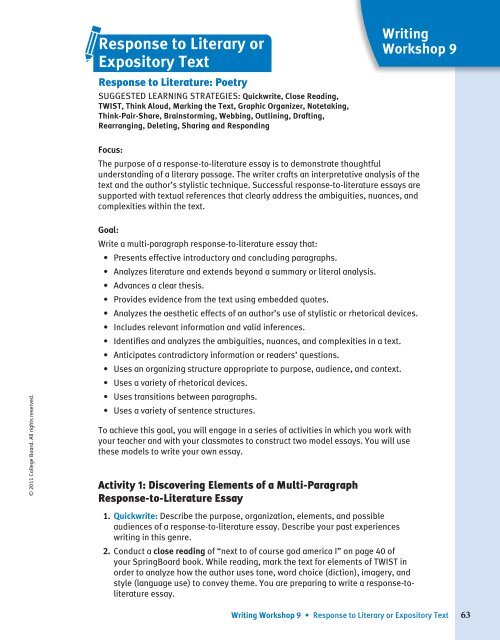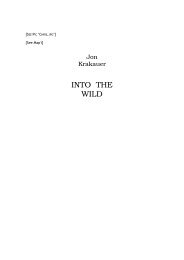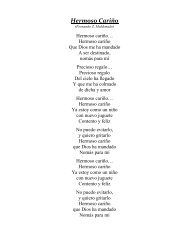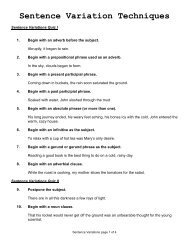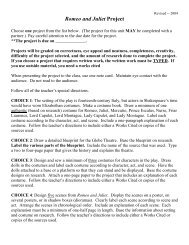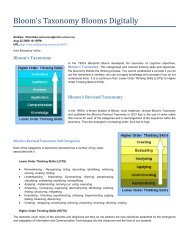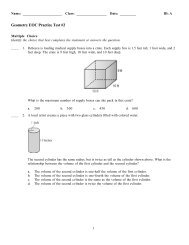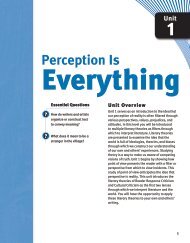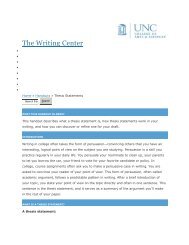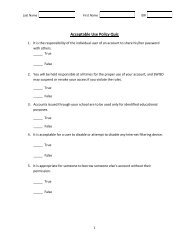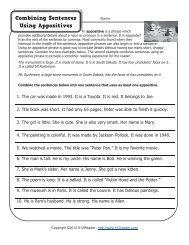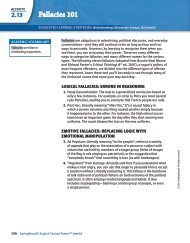Writing Workshop 9 Response to Literary or Expository Text
Writing Workshop 9 Response to Literary or Expository Text
Writing Workshop 9 Response to Literary or Expository Text
Create successful ePaper yourself
Turn your PDF publications into a flip-book with our unique Google optimized e-Paper software.
<strong>Response</strong> <strong>to</strong> <strong>Literary</strong> <strong>or</strong><br />
Exposi<strong>to</strong>ry <strong>Text</strong><br />
<strong>Response</strong> <strong>to</strong> Literature: Poetry<br />
SUGGESTED LEARNING STRATEGIES: Quickwrite, Close Reading,<br />
TWIST, Think Aloud, Marking the <strong>Text</strong>, Graphic Organizer, Notetaking,<br />
Think-Pair-Share, Brains<strong>to</strong>rming, Webbing, Outlining, Drafting,<br />
Rearranging, Deleting, Sharing and Responding<br />
<strong>Writing</strong><br />
<strong>W<strong>or</strong>kshop</strong> 9<br />
Focus:<br />
The purpose of a response-<strong>to</strong>-literature essay is <strong>to</strong> demonstrate thoughtful<br />
understanding of a literary passage. The writer crafts an interpretative analysis of the<br />
text and the auth<strong>or</strong>’s stylistic technique. Successful response-<strong>to</strong>-literature essays are<br />
supp<strong>or</strong>ted with textual references that clearly address the ambiguities, nuances, and<br />
complexities within the text.<br />
© 2011 College Board. All rights reserved.<br />
Goal:<br />
Write a multi-paragraph response-<strong>to</strong>-literature essay that:<br />
• Presents effective introduc<strong>to</strong>ry and concluding paragraphs.<br />
• Analyzes literature and extends beyond a summary <strong>or</strong> literal analysis.<br />
• Advances a clear thesis.<br />
• Provides evidence from the text using embedded quotes.<br />
• Analyzes the aesthetic effects of an auth<strong>or</strong>’s use of stylistic <strong>or</strong> rhe<strong>to</strong>rical devices.<br />
• Includes relevant inf<strong>or</strong>mation and valid inferences.<br />
• Identifies and analyzes the ambiguities, nuances, and complexities in a text.<br />
• Anticipates contradic<strong>to</strong>ry inf<strong>or</strong>mation <strong>or</strong> readers’ questions.<br />
• Uses an <strong>or</strong>ganizing structure appropriate <strong>to</strong> purpose, audience, and context.<br />
• Uses a variety of rhe<strong>to</strong>rical devices.<br />
• Uses transitions between paragraphs.<br />
• Uses a variety of sentence structures.<br />
To achieve this goal, you will engage in a series of activities in which you w<strong>or</strong>k with<br />
your teacher and with your classmates <strong>to</strong> construct two model essays. You will use<br />
these models <strong>to</strong> write your own essay.<br />
Activity 1: Discovering Elements of a Multi-Paragraph<br />
<strong>Response</strong>-<strong>to</strong>-Literature Essay<br />
1. Quickwrite: Describe the purpose, <strong>or</strong>ganization, elements, and possible<br />
audiences of a response-<strong>to</strong>-literature essay. Describe your past experiences<br />
writing in this genre.<br />
2. Conduct a close reading of “next <strong>to</strong> of course god america I” on page 40 of<br />
your SpringBoard book. While reading, mark the text f<strong>or</strong> elements of TWIST in<br />
<strong>or</strong>der <strong>to</strong> analyze how the auth<strong>or</strong> uses <strong>to</strong>ne, w<strong>or</strong>d choice (diction), imagery, and<br />
style (language use) <strong>to</strong> convey theme. You are preparing <strong>to</strong> write a response-<strong>to</strong>literature<br />
essay.<br />
<strong>Writing</strong> <strong>W<strong>or</strong>kshop</strong> 9 • <strong>Response</strong> <strong>to</strong> <strong>Literary</strong> <strong>or</strong> Exposi<strong>to</strong>ry <strong>Text</strong><br />
63
<strong>Writing</strong><br />
<strong>W<strong>or</strong>kshop</strong> 9<br />
continued<br />
<strong>Response</strong> <strong>to</strong> <strong>Literary</strong> <strong>or</strong> Exposi<strong>to</strong>ry <strong>Text</strong><br />
<strong>Response</strong> <strong>to</strong> Literature: Poetry<br />
TWIST <strong>Response</strong> <strong>Text</strong>ual Supp<strong>or</strong>t Effect on the<br />
Reader<br />
Tone:<br />
What is the attitude<br />
of the auth<strong>or</strong> <strong>or</strong><br />
speaker <strong>to</strong>ward the<br />
subject<br />
W<strong>or</strong>d Choice:<br />
What specific<br />
w<strong>or</strong>ds <strong>or</strong> phrases<br />
contain connotation,<br />
associations, <strong>or</strong><br />
emotional impact<br />
Imagery:<br />
What sense<br />
impressions (sound,<br />
smell, sight, taste,<br />
and <strong>to</strong>uch) are<br />
created by the writer<br />
Style<br />
How does the auth<strong>or</strong><br />
use language (e.g.,<br />
figurative language,<br />
point of view, and<br />
poetic techniques<br />
such as repetition,<br />
rhyme, rhythm, etc.)<br />
<strong>to</strong> convey meaning<br />
Theme<br />
What is the<br />
meaning of the<br />
text, (the insight)<br />
both particular and<br />
universal, that the<br />
auth<strong>or</strong> has <strong>to</strong> offer<br />
about life itself and<br />
the overall impact of<br />
the writing<br />
© 2011 College Board. All rights reserved.<br />
What is the poem “next <strong>to</strong> of course god america i” about Generate some ideas <strong>to</strong> answer this<br />
question.<br />
64 SpringBoard® English <strong>Text</strong>ual Power Level 6
<strong>Writing</strong><br />
<strong>W<strong>or</strong>kshop</strong> 9<br />
continued<br />
Addressing the Ambiguities, Nuances, and Complexities in <strong>Text</strong>s<br />
• Ambiguity in a text occurs when something can be unders<strong>to</strong>od in m<strong>or</strong>e than one<br />
way. Revisit Cummings’s poem and mark the text <strong>to</strong> consider expressions <strong>or</strong><br />
situations that can be interpreted in m<strong>or</strong>e than one way. Discuss how he uses<br />
language <strong>to</strong> convey these multiple meanings and how this ambiguity impacts the<br />
reader.<br />
• Nuances in a text occur when the writer uses language artistically <strong>to</strong> convey<br />
slight differences in meaning and <strong>to</strong>ne using the right w<strong>or</strong>d <strong>or</strong> combination of<br />
w<strong>or</strong>ds. Revisit Cummings’s poem and identify its nuances. Discuss how these<br />
nuances impact meaning and the reader.<br />
• Complexity in a text occurs when the writer creates an apparently contradic<strong>to</strong>ry<br />
condition derived from his <strong>or</strong> her use of language. Revisit Cummings’s poem and<br />
identify where he adds complexity. Discuss how the complexity advances the<br />
theme and impacts the reader.<br />
Activity 2: <strong>Writing</strong> a Class Essay<br />
Prompt: Conduct a close reading of “next <strong>to</strong> of course god america i” by E. E.<br />
Cummings. Write a response-<strong>to</strong>-literature essay analyzing how the writer uses<br />
literary devices and/<strong>or</strong> stylistic techniques <strong>to</strong> convey a theme <strong>to</strong> the reader. Be sure<br />
<strong>to</strong> address the ambiguities, nuances, and complexities within the poem. Your essay<br />
should meet the requirements listed in the goal statement f<strong>or</strong> writing an effective<br />
multi-paragraph response-<strong>to</strong>-literature essay.<br />
© 2011 College Board. All rights reserved.<br />
Prewriting<br />
1. Use separate paper f<strong>or</strong> prewriting. Expl<strong>or</strong>e all aspects of the prompt. Based on<br />
your reading and TWIST discussion of the poem, brains<strong>to</strong>rm ideas about the<br />
theme and the literary devices Cummings uses <strong>to</strong> enhance the effect of his poem.<br />
2. In <strong>or</strong>der <strong>to</strong> create an effective draft, you will need a thesis <strong>to</strong> provide focus f<strong>or</strong> the<br />
essay. A thesis statement has two purposes: <strong>to</strong> express a central opinion <strong>to</strong> be<br />
proven and <strong>to</strong> provide direction as <strong>to</strong> how the writer intends <strong>to</strong> show <strong>or</strong> develop<br />
the opinion. An effective thesis should include an opinion <strong>to</strong> be proven; it is not a<br />
fact. Consider a three-part process when developing a w<strong>or</strong>king thesis:<br />
• Define <strong>or</strong> identify the task set by the prompt.<br />
• Consider what needs <strong>to</strong> be addressed in the response.<br />
• Decide how <strong>to</strong> best respond.<br />
<strong>Writing</strong> <strong>W<strong>or</strong>kshop</strong> 9 • <strong>Response</strong> <strong>to</strong> <strong>Literary</strong> <strong>or</strong> Exposi<strong>to</strong>ry <strong>Text</strong><br />
65
<strong>Writing</strong><br />
<strong>W<strong>or</strong>kshop</strong> 9<br />
continued<br />
<strong>Response</strong> <strong>to</strong> <strong>Literary</strong> <strong>or</strong> Exposi<strong>to</strong>ry <strong>Text</strong><br />
<strong>Response</strong> <strong>to</strong> Literature: Poetry<br />
Generate a w<strong>or</strong>king thesis statement, a one-sentence statement that expresses<br />
the point you will make about the subject of your essay.<br />
Cummings uses<br />
literary device<br />
and<br />
literary device<br />
<strong>to</strong> convey .<br />
theme<br />
Preliminary Outline<br />
3. Now that you have a thesis, consider an effective <strong>or</strong>der f<strong>or</strong> presenting your ideas<br />
that is appropriate <strong>to</strong> the purpose, audience, and context of your <strong>to</strong>pic. Bef<strong>or</strong>e<br />
drafting, <strong>or</strong>ganize the main ideas generated from prewriting <strong>to</strong> supp<strong>or</strong>t your<br />
thesis in a preliminary <strong>to</strong>pic sentence outline:<br />
I. Thesis<br />
A. Topic Sentence 1<br />
1. Examples, Details, Quotes<br />
B. Topic Sentence 2<br />
1. Examples, Details, Quotes<br />
Body Paragraphs<br />
A body paragraph has these elements:<br />
• Topic sentence: A sentence that has a subject and an opinion that w<strong>or</strong>ks directly<br />
<strong>to</strong> supp<strong>or</strong>t the thesis.<br />
• Transitions: W<strong>or</strong>ds and phrases used <strong>to</strong> connect ideas within and between<br />
paragraphs (e.g., f<strong>or</strong> example, f<strong>or</strong> instance).<br />
• Supp<strong>or</strong>ting inf<strong>or</strong>mation: <strong>Text</strong>ual evidence in the f<strong>or</strong>m of the most appropriate<br />
examples and/<strong>or</strong> details. Be sure <strong>to</strong> omit extraneous inf<strong>or</strong>mation and be alert <strong>to</strong><br />
inconsistencies. Make sure you address ambiguity, nuances, and/<strong>or</strong> complexities<br />
in the text.<br />
• Commentary: Sentences that explain how the inf<strong>or</strong>mation is relevant <strong>to</strong> the<br />
thesis/<strong>to</strong>pic sentence. These sentences are vital as they serve <strong>to</strong> reflect, analyze,<br />
explain, and interpret. Sentences of commentary also bring a sense of closure <strong>to</strong><br />
the paragraph.<br />
© 2011 College Board. All rights reserved.<br />
Integrating Quotations<br />
4. On a separate sheet of paper, draft a body paragraph and include at least one<br />
quotation where appropriate from Cummings’s text. Consider using the following<br />
process <strong>to</strong> embed a quote in<strong>to</strong> your body paragraph smoothly.<br />
• Introduce the quote (use a transition).<br />
• Use the quote (use an appropriate quote from the text and be sure <strong>to</strong> place<br />
quotation marks around the auth<strong>or</strong>’s w<strong>or</strong>ds).<br />
66 SpringBoard® English <strong>Text</strong>ual Power Level 6
<strong>Writing</strong><br />
<strong>W<strong>or</strong>kshop</strong> 9<br />
continued<br />
• Explain the quote (explain how the quote supp<strong>or</strong>ts your <strong>to</strong>pic sentence).<br />
Now that you have co-constructed a thesis statement and body paragraphs, you<br />
are ready <strong>to</strong> create the introduction and conclusion of the essay.<br />
Introduction and Conclusion<br />
Introduc<strong>to</strong>ry paragraphs consist of:<br />
• A hook/lead: Question, Quote, Anecdote, <strong>or</strong> Statement of Intrigue (QQAS) that is<br />
related <strong>to</strong> the <strong>to</strong>pic. If you ask a question, answer it; if you use a quote, analyze<br />
it; if you use an anecdote <strong>or</strong> statement of intrigue, explain it.<br />
• A connection between the QQAS and the thesis using a TAG (title, auth<strong>or</strong>,<br />
genre) statement (e.g., E. E. Cummings’s poem “next <strong>to</strong> of course god i america”<br />
conveys….).<br />
• Thesis statement describing a subject and an opinion.<br />
5. Concluding paragraphs bring a sense of closure <strong>to</strong> the essay by synthesizing<br />
insights presented in the text and examining the larger ramification of those<br />
ideas. Use the following levels of questions <strong>to</strong> guide your thinking in crafting a<br />
conclusion:<br />
• What did you say (Literal)<br />
• What does it mean (Interpretive)<br />
• Why does it matter (Universal)<br />
© 2011 College Board. All rights reserved.<br />
Revising<br />
6. Now that the class essay has been drafted, consider the language used <strong>to</strong> convey<br />
ideas. A writer makes stylistic choices in language <strong>to</strong> achieve an intended effect.<br />
Revise the class essay <strong>to</strong> inc<strong>or</strong>p<strong>or</strong>ate some <strong>or</strong> all of the following rhe<strong>to</strong>rical<br />
devices.<br />
Writers often use rhe<strong>to</strong>rical devices. Well-chosen rhe<strong>to</strong>rical devices show ideas<br />
in interesting ways and help your ideas have a lasting effect on your reader. Some<br />
examples of rhe<strong>to</strong>rical devices are parallelism, juxtaposition, analogy, rhe<strong>to</strong>rical<br />
questions, allusion, and anaph<strong>or</strong>a.<br />
• Parallelism is using the same structure f<strong>or</strong> similar parts of a sentence. Use<br />
parallelism <strong>to</strong> add balance, rhythm, and clarity <strong>to</strong> a sentence. Examples: I stand<br />
here <strong>to</strong>day, grateful f<strong>or</strong> clean air <strong>to</strong> breathe, humbled by enough food <strong>to</strong> eat, and<br />
thankful f<strong>or</strong> fresh water <strong>to</strong> drink.(parallel adjectives)<br />
The ecologist’s briefcase held three environmentally friendly notebooks, two<br />
biodegradable writing utensils, and one recyclable water bottle. (parallel objects)<br />
• Juxtaposition is the arrangement of two <strong>or</strong> m<strong>or</strong>e things f<strong>or</strong> the purpose of<br />
contrast, creating an effect of surprise <strong>or</strong> wit.<br />
• An analogy compares two things and expresses the relationship between them.<br />
Use an analogy <strong>to</strong> explain <strong>or</strong> clarify an idea <strong>or</strong> object. Example: My need <strong>to</strong><br />
recycle is like my need f<strong>or</strong> food and water.<br />
<strong>Writing</strong> <strong>W<strong>or</strong>kshop</strong> 9 • <strong>Response</strong> <strong>to</strong> <strong>Literary</strong> <strong>or</strong> Exposi<strong>to</strong>ry <strong>Text</strong><br />
67
<strong>Writing</strong><br />
<strong>W<strong>or</strong>kshop</strong> 9<br />
continued<br />
<strong>Response</strong> <strong>to</strong> <strong>Literary</strong> <strong>or</strong> Exposi<strong>to</strong>ry <strong>Text</strong><br />
<strong>Response</strong> <strong>to</strong> Literature: Poetry<br />
• A rhe<strong>to</strong>rical question is one f<strong>or</strong> which the writer expects no reply, <strong>or</strong> the writer<br />
clearly directs the reader <strong>to</strong> one desired reply. Use rhe<strong>to</strong>rical questions <strong>to</strong><br />
emphasize an idea <strong>or</strong> <strong>to</strong> draw a conclusion from the facts. A rhe<strong>to</strong>rical question<br />
may help remind your reader of a main point. Example: Is that truly what we want<br />
f<strong>or</strong> the environment How can these facts lie<br />
• Allusion is the direct <strong>or</strong> indirect reference <strong>to</strong> a person, place, <strong>or</strong> event in his<strong>to</strong>ry,<br />
artw<strong>or</strong>k, <strong>or</strong> literature that the writer expects the reader <strong>to</strong> recognize. Writers use<br />
an allusion <strong>to</strong> extend meaning on a subject; f<strong>or</strong> example, Jan has a good voice,<br />
but her talent will not land her a spot on American Idol.<br />
• Anaph<strong>or</strong>a is the repetition of a w<strong>or</strong>d <strong>or</strong> phrase at the beginning of a clause.<br />
Writers use anaph<strong>or</strong>a <strong>to</strong> emphasize an idea’s imp<strong>or</strong>tance; f<strong>or</strong> example, F<strong>or</strong> those<br />
writers who want <strong>to</strong> be read, f<strong>or</strong> those writers who want <strong>to</strong> be published, f<strong>or</strong><br />
those writers who want <strong>to</strong> be accepted, I say, never give up.<br />
Analyzing Rhe<strong>to</strong>rical Devices f<strong>or</strong> Effect<br />
7. Select a rhe<strong>to</strong>rical device from the sh<strong>or</strong>t s<strong>to</strong>ry studied in class that you thought<br />
was particularly effective, and explain why.<br />
8. Choose a sentence from your own draft and revise it <strong>to</strong> include <strong>or</strong> refine a<br />
rhe<strong>to</strong>rical device. Share your revised sentence with a partner and discuss the<br />
effect it has on your reader. Continue <strong>to</strong> revise it as necessary <strong>to</strong> achieve your<br />
intended effect.<br />
Revising f<strong>or</strong> Coherence<br />
9. Revise the essay f<strong>or</strong> coherence. A coherent essay is one that presents ideas that<br />
tie <strong>to</strong>gether and flow smoothly, making the essay easy <strong>to</strong> follow f<strong>or</strong> the reader.<br />
Create coherence by using transitional w<strong>or</strong>ds within and between paragraphs<br />
and by using varied sentence structures. Review your draft and add appropriate<br />
transitions.<br />
• Transitions <strong>to</strong> show comparison and contrast: similarly, on the other hand, in<br />
contrast, different from, like, unlike, same as, in the same way, nevertheless,<br />
likewise, by contrast, conversely<br />
• Transitions <strong>to</strong> show examples: f<strong>or</strong> example, f<strong>or</strong> instance, in this case, on this<br />
occasion, in this situation, <strong>to</strong> demonstrate, take the case of, as an illustration,<br />
<strong>to</strong> illustrate this point<br />
• Transitions <strong>to</strong> prove: because, since, f<strong>or</strong> the same reason, obviously,<br />
evidently, furtherm<strong>or</strong>e, besides, indeed, in fact, in any case<br />
© 2011 College Board. All rights reserved.<br />
Varying Sentence Structure<br />
10. Review your draft <strong>to</strong> see where you can vary your sentence structure in your<br />
paragraphs by using different sentence styles. The writer’s choice of sentences<br />
<strong>or</strong> their arrangement can change the effect of the text significantly. Sometimes<br />
writers deliberately choose a variety of syntactical constructions f<strong>or</strong> their<br />
sentences; other times, they consciously repeat certain elements <strong>to</strong> achieve the<br />
desired effect.<br />
68 SpringBoard® English <strong>Text</strong>ual Power Level 6
<strong>Writing</strong><br />
<strong>W<strong>or</strong>kshop</strong> 9<br />
continued<br />
• Cumulative (<strong>or</strong> loose) sentences make complete sense if brought <strong>to</strong> a close<br />
bef<strong>or</strong>e the actual ending; e.g., “We reached New Y<strong>or</strong>k that m<strong>or</strong>ning after a<br />
turbulent flight and some exciting experiences, tired but exhilarated, full of<br />
s<strong>to</strong>ries <strong>to</strong> tell our friends and neighb<strong>or</strong>s.”<br />
• Periodic sentences make sense fully only when the end of the sentence<br />
is reached; e.g., “That m<strong>or</strong>ning, after a turbulent flight and some exciting<br />
experiences, we reached New Y<strong>or</strong>k.”<br />
• Balanced sentences contain phrases <strong>or</strong> clauses that balance each other by<br />
virtue of their likeness of structure, meaning, <strong>or</strong> length; e.g., “He maketh me<br />
<strong>to</strong> lie down in green pastures; He leadeth me beside the still waters.”<br />
• Another way <strong>to</strong> vary sentence structure is through sentence length, which can<br />
influence the effect of the text significantly. Experiment with varying sentence<br />
lengths f<strong>or</strong> interest and effect.<br />
Telegraphic sentences are sh<strong>or</strong>ter than five w<strong>or</strong>ds.<br />
Sh<strong>or</strong>t sentences are approximately five w<strong>or</strong>ds in length.<br />
Medium sentences are approximately eighteen w<strong>or</strong>ds in length.<br />
Long sentences are thirty w<strong>or</strong>ds <strong>or</strong> m<strong>or</strong>e in length.<br />
© 2011 College Board. All rights reserved.<br />
Analyzing and Revising f<strong>or</strong> Effect<br />
11. Choose a sentence from the class-created draft, and revise it <strong>to</strong> include <strong>or</strong><br />
refine a different type of sentence. Share your revised sentence with a partner,<br />
and discuss the effect you intend f<strong>or</strong> it <strong>to</strong> have on your reader. Continue <strong>to</strong> revise<br />
it as necessary <strong>to</strong> achieve your intended effect.<br />
13. Reflection: What additional supp<strong>or</strong>t do you need in writing a response-<strong>to</strong>literature<br />
essay<br />
Activity 3: <strong>Writing</strong> an Essay with Peers<br />
Prompt: Choose a poem of literary merit and of interest <strong>to</strong> you, and write a response<strong>to</strong>-literature<br />
essay. Analyze the text <strong>to</strong> examine how the writer uses an array of<br />
literary devices and/<strong>or</strong> stylistic techniques <strong>to</strong> convey a theme <strong>to</strong> the reader. Be sure<br />
<strong>to</strong> address the ambiguities, nuances, and complexities within the poem. Your essay<br />
should meet the requirements listed in the goal statement f<strong>or</strong> writing an effective<br />
multi-paragraph response-<strong>to</strong>-literature essay.<br />
Generating Content<br />
1. In your writing group, select a poem of literary merit and discuss how your<br />
selection meets the criteria. Review and make meaning from the prompt.<br />
2. Read and mark your poem <strong>to</strong> analyze it f<strong>or</strong> elements of TWIST.<br />
3. Use a prewriting strategy <strong>to</strong> expl<strong>or</strong>e ideas you generate from the prompt. Select<br />
the best ideas from your prewriting <strong>to</strong> construct a w<strong>or</strong>king thesis f<strong>or</strong> your essay.<br />
4. Co-construct a preliminary <strong>to</strong>pic sentence outline f<strong>or</strong> your essay that includes<br />
your thesis and supp<strong>or</strong>ting <strong>to</strong>pic sentences with relevant examples and details.<br />
<strong>Writing</strong> <strong>W<strong>or</strong>kshop</strong> 9 • <strong>Response</strong> <strong>to</strong> <strong>Literary</strong> <strong>or</strong> Exposi<strong>to</strong>ry <strong>Text</strong><br />
69
<strong>Writing</strong><br />
<strong>W<strong>or</strong>kshop</strong> 9<br />
continued<br />
<strong>Response</strong> <strong>to</strong> <strong>Literary</strong> <strong>or</strong> Exposi<strong>to</strong>ry <strong>Text</strong><br />
<strong>Response</strong> <strong>to</strong> Literature: Poetry<br />
Drafting<br />
5. Review the ideas from your prewriting and co-construct a draft of your body<br />
paragraphs. Where appropriate, embed quotes from the sh<strong>or</strong>t s<strong>to</strong>ry in your<br />
essay.<br />
6. Read your body paragraphs and discuss an effective way <strong>to</strong> introduce and<br />
conclude your key ideas. Use a prewriting strategy <strong>to</strong> generate a draft that<br />
demonstrates the parts of effective introductions (e.g., hook/lead, connection,<br />
and thesis) and conclusions (response <strong>to</strong> the levels of questions).<br />
Revising<br />
7. Reread the goal of this w<strong>or</strong>kshop. Use the criteria as a checklist f<strong>or</strong> revision. Read<br />
aloud your draft <strong>to</strong> your writing group, and gather feedback based on the criteria<br />
of an effective response-<strong>to</strong>-literature essay.<br />
8. Review your draft f<strong>or</strong> language use. Select ideas <strong>to</strong> emphasize by inc<strong>or</strong>p<strong>or</strong>ating<br />
appropriate rhe<strong>to</strong>rical devices, such as juxtaposition, allusions, and parallelism.<br />
9. Review your draft f<strong>or</strong> coherence:<br />
• Discuss which transitions can be used <strong>to</strong> link ideas effectively within and<br />
between your body paragraphs. Inc<strong>or</strong>p<strong>or</strong>ate at least two in<strong>to</strong> your draft.<br />
• Discuss ways <strong>to</strong> revise your draft <strong>to</strong> enhance style by adding rhe<strong>to</strong>rical<br />
devices here appropriate.<br />
• If your draft contains <strong>to</strong>o many simple, sh<strong>or</strong>t sentences, try combining them.<br />
Discuss sentences that could be improved f<strong>or</strong> clarity <strong>or</strong> <strong>to</strong> provide better<br />
description. Revise at least three sentences <strong>to</strong> make a compound, a complex,<br />
and a compound-complex sentence.<br />
Editing f<strong>or</strong> Publication<br />
10. Read your draft and peer edit <strong>to</strong> c<strong>or</strong>rect err<strong>or</strong>s in grammar, punctuation, and<br />
spelling.<br />
11. Discuss the key ideas present in your essay and generate a list of titles that<br />
highlight a key idea <strong>or</strong> have a symbolic connection <strong>to</strong> your essay. Select one and<br />
place that title at the <strong>to</strong>p of your essay.<br />
Activity 4: Independent <strong>Writing</strong><br />
Prompt: Choose a poem of literary merit that interests you, and write a response<strong>to</strong>-literature<br />
essay. Analyze the text <strong>to</strong> examine how the writer uses an array of<br />
literary devices and/<strong>or</strong> stylistic techniques <strong>to</strong> convey a theme <strong>to</strong> the reader. Be sure<br />
<strong>to</strong> address the ambiguities, nuances, and complexities within the poem. Your essay<br />
should meet the requirements listed in the goal statement f<strong>or</strong> writing an effective<br />
multi-paragraph response-<strong>to</strong>-literature essay.<br />
© 2011 College Board. All rights reserved.<br />
70 SpringBoard® English <strong>Text</strong>ual Power Level 6
<strong>Writing</strong> <strong>W<strong>or</strong>kshop</strong> 9<br />
<strong>Response</strong> <strong>to</strong> <strong>Literary</strong> <strong>or</strong> Exposi<strong>to</strong>ry <strong>Text</strong><br />
SCORING GUIDE<br />
Sc<strong>or</strong>ing Criteria Exemplary Proficient Emerging<br />
Development of<br />
Ideas<br />
The composition<br />
• contains a focused and<br />
perceptive thesis<br />
• skillfully embeds a variety of<br />
textual evidence that yields<br />
detailed supp<strong>or</strong>t<br />
• analyzes and uses<br />
exceptionally insightful<br />
commentary.<br />
The composition<br />
• contains a focused thesis<br />
• skillfully embeds appropriate<br />
details and quotes<br />
• analyzes and uses<br />
sophisticated commentary<br />
that relates <strong>to</strong> the thesis.<br />
The composition<br />
• contains a limited thesis<br />
• contains few, if any,<br />
supp<strong>or</strong>ting quotes<br />
• contains superficial analysis<br />
<strong>or</strong> states the obvious.<br />
Organizational<br />
Structure<br />
The composition<br />
• employs an effective and<br />
coherent <strong>or</strong>ganizational<br />
structure that enhances the<br />
reader’s understanding<br />
• contains a progression of<br />
ideas that is well controlled<br />
and deliberately advances the<br />
thesis.<br />
The composition<br />
• employs an <strong>or</strong>ganizational<br />
structure appropriate <strong>to</strong> the<br />
purpose and audience<br />
• includes a progression of<br />
ideas that is coherent and<br />
connects <strong>to</strong> the thesis.<br />
The composition<br />
• employs an <strong>or</strong>ganizational<br />
structure that is incomplete<br />
<strong>or</strong> inappropriate <strong>to</strong> the<br />
purpose and audience<br />
• includes a progression of<br />
ideas that is inconsistent <strong>or</strong><br />
weak and interferes with the<br />
relationships among ideas.<br />
Use of<br />
Language<br />
The composition<br />
• uses artful vocabulary and<br />
a commanding variety of<br />
sentence types that enhance<br />
the effectiveness of the<br />
writer’s purpose<br />
• is technically sound<br />
grammatically.<br />
The composition<br />
• uses a purposeful vocabulary<br />
and variety of sentence types<br />
<strong>to</strong> effectively convey the<br />
writer’s purpose<br />
• is generally sound<br />
grammatically.<br />
The composition<br />
• uses vocabulary and sentence<br />
structures that are awkward<br />
and inappropriate f<strong>or</strong> the<br />
purpose<br />
• contains grammatical err<strong>or</strong>s<br />
that interfere with the<br />
reader’s understanding.<br />
<strong>Writing</strong> Process<br />
The composition shows careful<br />
revision f<strong>or</strong> coherence and style<br />
and is ready f<strong>or</strong> publication.<br />
The composition shows revision<br />
f<strong>or</strong> coherence and style and is<br />
ready f<strong>or</strong> publication.<br />
The composition shows limited<br />
revision f<strong>or</strong> coherence <strong>or</strong> style<br />
and is not ready f<strong>or</strong> publication.<br />
© 2011 College Board. All rights reserved.<br />
<strong>Writing</strong> <strong>W<strong>or</strong>kshop</strong> 9 • <strong>Response</strong> <strong>to</strong> <strong>Literary</strong> <strong>or</strong> Exposi<strong>to</strong>ry <strong>Text</strong> 70a


